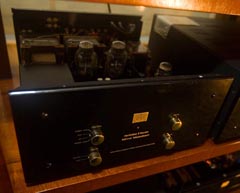

Altogether, this would create a system that cost more than my first three-bedroom house and ought to help show the Jinro off to the best of its ability. Carlo not only delivered the amp but also supplied a pair of ART Monitor Diamond speakers and a COS D1 DAC along with DRAM speaker cables and interconnects and a pair of Incredibly solid Target speaker stands. The Jinro used for this review was supplied by Audio Note dealer Carlo Marengo of Audio-philia in Edinburgh. The Jinro is an integrated design running pure Class A and utilising a pair of 211 output triodes to give a maximum output of 20 Watts a channel. Fortunately, a couple of weeks previously, I’d had cause to stand on top of an old wooden Victorian blanket box and knew that if it supported my weight without complaint then 85 pounds wasn’t going to be a problem so it was pressed into service as a hifi support and, damped internally by blankets and cushions, a jolly good job it did too. And that wasn’t a phone call I wanted to make.
#Audionote ginrei crack#
It was also possible though, that after about 30 seconds, there would have been an almighty crack and the whole shebang, Jinro and all, would have come crashing to the floor. At 26 inches deep, or more likely long, – do you know anyone who has a 26-inch deep shelf? – and weighing 85 pounds, the Jinro might have been able to sit lengthways on my glass-shelved Stands Unique rack. The Jinro is not, in any sense, your average integrated amplifier. Quite simply, where was I going to put it? Personally, I experienced a brief combination of gratitude and excitement before a more practical concern burst my bubble. When you discover that you are going to be spending some time at home with Audio Note UK’s celebrated Jinro integrated amplifier there are many thoughts and emotions that might run through your head.


Whether it is measured in pounds and ounces or pounds and pence, John Scott finds that Audio Note’s Jinro is a heavyweight champion that doesn’t pull any punches.


 0 kommentar(er)
0 kommentar(er)
